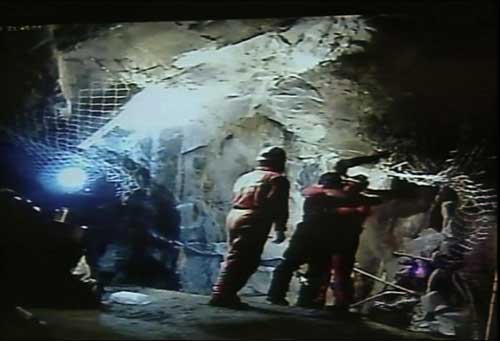Global General
Sports sunglasses aim to ease miners' transition
(Agencies)
Updated: 2010-10-14 09:51
 |
Large Medium Small |
NEW YORK - The sometimes tear-filled eyes of rescued miners in Chile are being shielded by a type of Oakley sunglasses designed to minimize heavy glare.
The single-lens shield is a wraparound style. Using the darkest lens with a gray base and black iridium coating should help the miners' eyes adjust to bright light after being dilated so long, the California company said in a statement.
 A video image shows rescuers hugging each other in celebration after the last of the 33 trapped miners left the underground mine in Chile on Oct 13, 2010. [Photo/Agencies] |
| ||||
The glasses are typically used for high-performance sports such as biking and skiing because they also minimize UV light. An exterior coating should help prevent water, mud, oil and dust from building up on the surface as the miners are hoisted to freedom, the company said.
The biggest eye concern for the miners as they reach the surface includes possible light damage to the retina, said Dr. Andrew Hartwick, assistant professor at the College of Optometry at Ohio State University. There is potential for solar retinopathy, in which the photoreceptors - the cells within the eye that capture light - can deteriorate, he said.
After being in the dark for a long period, the mechanisms by which the retina protects itself against damage from bright light can diminish, but Hartwick was unsure if lighting conditions in the mine were low enough to be dangerous. The miners spent 69 days deep underground after a cave-in.
Regardless of any medical consequences, there's a comfort factor for the miners in wearing sunglasses, Hartwick said.
"Just like when you walk out of a dark movie theater, it's uncomfortable in the light," he said. "It takes a few minutes for vision to return, and the retina needs to reset itself depending on light levels."
"Oakley is honored to have assisted Chilean authorities in the rescue operation for the trapped miners," said Carlos Reyes, vice president of research and development at Oakley. The goal is to give them "the best possible vision" as their eyes return to normal.
Journalist Jonathan Franklin, who is covering the disaster and rescue in Chile, contacted Oakley about donating sunglasses.
The Radar glasses typically retail for $180. No adjustments were made to the pairs sent to the miners, though Oakley include two lens shapes to accommodate different face shapes.
Many agencies and companies around the world contributed expertise or products related to the rescue, from a high-calorie liquid diet, donated by NASA, to suppress motion sickness in the miners as they ascended; to iPods donated by Apple, which the miners were to receive when they emerged. Gifts for their families donated by unions, companies and individuals have ranged from food and clothing to sexy lingerie, wine, toys and children's Halloween costumes.



